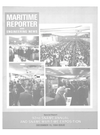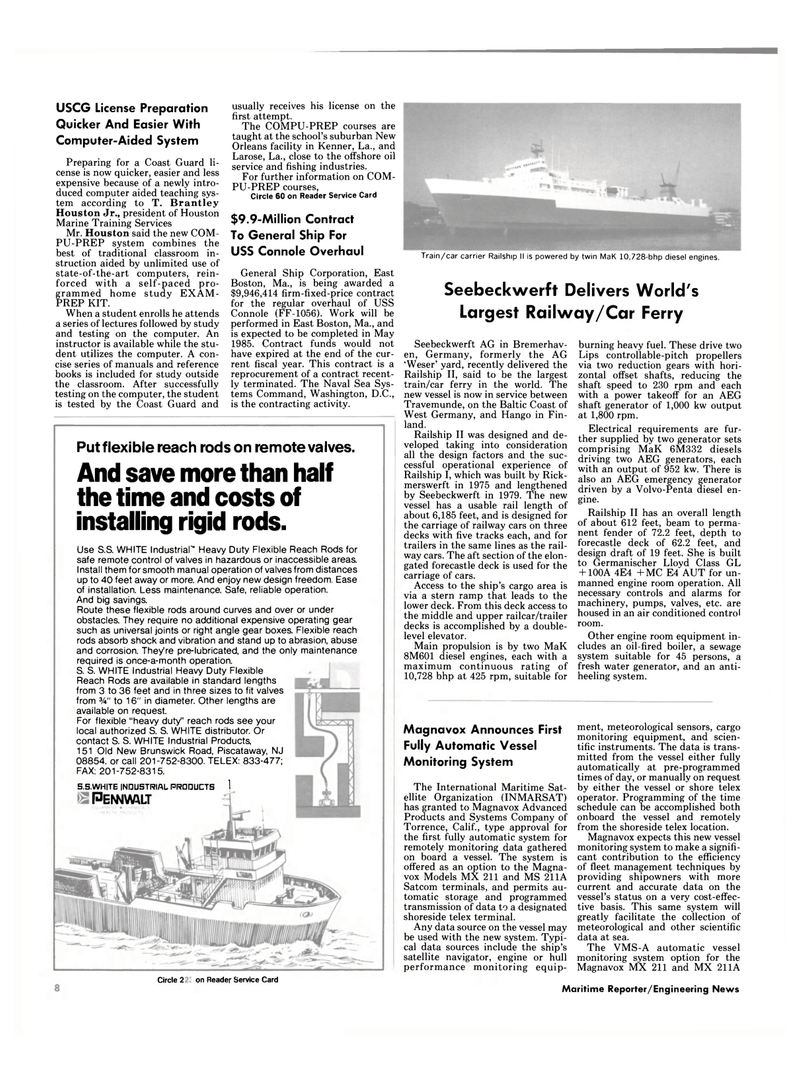
Page 6: of Maritime Reporter Magazine (December 15, 1984)
Read this page in Pdf, Flash or Html5 edition of December 15, 1984 Maritime Reporter Magazine
USCG License Preparation
Quicker And Easier With
Computer-Aided System
Preparing for a Coast Guard li- cense is now quicker, easier and less expensive because of a newly intro- duced computer aided teaching sys- tem according to T. Brantley
Houston Jr., president of Houston
Marine Training Services
Mr. Houston said the new COM-
PU-PREP system combines the best of traditional classroom in- struction aided by unlimited use of state-of-the-art computers, rein- forced with a self-paced pro- grammed home study EXAM-
PREP KIT.
When a student enrolls he attends a series of lectures followed by study and testing on the computer. An instructor is available while the stu- dent utilizes the computer. A con- cise series of manuals and reference books is included for study outside the classroom. After successfully testing on the computer, the student is tested by the Coast Guard and usually receives his license on the first attempt .
The COMPU-PREP courses are taught at the school's suburban New
Orleans facility in Kenner, La., and
Larose, La., close to the offshore oil service and fishing industries.
For further information on COM-
PU-PREP courses,
Circle 60 on Reader Service Card $9.9-Million Contract
To General Ship For
USS Connole Overhaul
General Ship Corporation, East
Boston, Ma., is being awarded a $9,946,414 firm-fixed-price contract for the regular overhaul of USS
Connole (FF-1056). Work will be performed in East Boston, Ma., and is expected to be completed in May 1985. Contract funds would not have expired at the end of the cur- rent fiscal year. This contract is a reprocurement of a contract recent- ly terminated. The Naval Sea Sys- tems Command, Washington, D.C., is the contracting activity.
Put flexible reach rods on remote valves.
And save more than half the time and costs of installing rigid rods.
Use S.S. WHITE Industrial™ Heavy Duty Flexible Reach Rods for safe remote control of valves in hazardous or inaccessible areas.
Install them for smooth manual operation of valves from distances up to 40 feet away or more. And enjoy new design freedom. Ease of installation. Less maintenance. Safe, reliable operation.
And big savings.
Route these flexible rods around curves and over or under obstacles. They require no additional expensive operating gear such as universal joints or right angle gear boxes. Flexible reach rods absorb shock and vibration and stand up to abrasion, abuse and corrosion. They're pre-lubricated, and the only maintenance required is once-a-month operation.
S. S. WHITE Industrial Heavy Duty Flexible
Reach Rods are available in standard lengths from 3 to 36 feet and in three sizes to fit valves from %" to 16" in diameter. Other lengths are available on request.
For flexible "heavy duty" reach rods see your local authorized S. S. WHITE distributor. Or contact S. S. WHITE Industrial Products, 151 Old New Brunswick Road, Piscataway, NJ 08854. or call 201-752-8300. TELEX: 833-477;
FAX: 201-752-8315.
S.S.WHITE INDUSTRIAL PRODUCTS I
PENMALT
Train/car carrier Railship II is powered by twin MaK 10,728-bhp diesel engines.
Seebeckwerft Delivers World's
Largest Railway/Car Ferry
Seebeckwerft AG in Bremerhav- en, Germany, formerly the AG 'Weser' yard, recently delivered the
Railship II, said to be the largest train/car ferry in the world. The new vessel is now in service between
Travemunde, on the Baltic Coast of
West Germany, and Hango in Fin- land.
Railship II was designed and de- veloped taking into consideration all the design factors and the suc- cessful operational experience of
Railship I, which was built by Rick- merswerft in 1975 and lengthened by Seebeckwerft in 1979. The new vessel has a usable rail length of about 6,185 feet, and is designed for the carriage of railway cars on three decks with five tracks each, and for trailers in the same lines as the rail- way cars. The aft section of the elon- gated forecastle deck is used for the carriage of cars.
Access to the ship's cargo area is via a stern ramp that leads to the lower deck. From this deck access to the middle and upper railcar/trailer decks is accomplished by a double- level elevator.
Main propulsion is by two MaK 8M601 diesel engines, each with a maximum continuous rating of 10,728 bhp at 425 rpm, suitable for burning heavy fuel. These drive two
Lips controllable-pitch propellers via two reduction gears with hori- zontal offset shafts, reducing the shaft speed to 230 rpm and each with a power takeoff for an AEG shaft generator of 1,000 kw output at 1,800 rpm.
Electrical requirements are fur- ther supplied by two generator sets comprising MaK 6M332 diesels driving two AEG generators, each with an output of 952 kw. There is also an AEG emergency generator driven by a Volvo-Penta diesel en- gine.
Railship II has an overall length of about 612 feet, beam to perma- nent fender of 72.2 feet, depth to forecastle deck of 62.2 feet, and design draft of 19 feet. She is built to Germanischer Lloyd Class GL + 100A 4E4 +MC E4 AUT for un- manned engine room operation. All necessary controls and alarms for machinery, pumps, valves, etc. are housed in an air conditioned control room.
Other engine room equipment in- cludes an oil-fired boiler, a sewage system suitable for 45 persons, a fresh water generator, and an anti- heeling system.
Magnavox Announces First
Fully Automatic Vessel
Monitoring System
The International Maritime Sat- ellite Organization (INMARSAT) has granted to Magnavox Advanced
Products and Systems Company of
Torrence, Calif., type approval for the first fully automatic system for remotely monitoring data gathered on board a vessel. The system is offered as an option to the Magna- vox Models MX 211 and MS 211A
Satcom terminals, and permits au- tomatic storage and programmed transmission of data to a designated shoreside telex terminal.
Any data source on the vessel may be used with the new system. Typi- cal data sources include the ship's satellite navigator, engine or hull performance monitoring equip- ment, meteorological sensors, cargo monitoring equipment, and scien- tific instruments. The data is trans- mitted from the vessel either fully automatically at pre-programmed times of day, or manually on request by either the vessel or shore telex operator. Programming of the time schedule can be accomplished both onboard the vessel and remotely from the shoreside telex location.
Magnavox expects this new vessel monitoring system to make a signifi- cant contribution to the efficiency of fleet management techniques by providing shipowners with more current and accurate data on the vessel's status on a very cost-effec- tive basis. This same system will greatly facilitate the collection of meteorological and other scientific data at sea.
The VMS-A automatic vessel monitoring system option for the
Magnavox MX 211 and MX 211A
Circle 324 on Reader Service Card 8 Maritime Reporter/Engineering News

 5
5

 7
7
